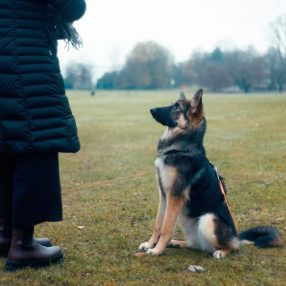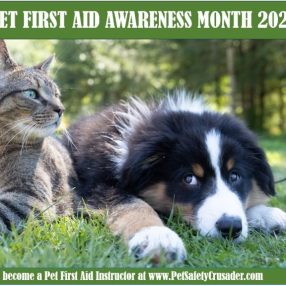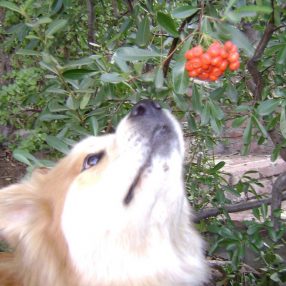 Head-to-Tail, Snout-to-Tail, Wag-to-Woof or by any other name, performing an at-home exam of your dog or cat weekly to catch problems early on is a MUST!
Head-to-Tail, Snout-to-Tail, Wag-to-Woof or by any other name, performing an at-home exam of your dog or cat weekly to catch problems early on is a MUST!
Dogs and cats don’t tell us when something is wrong. Responsible pet parents regularly look and feel to find anything not quite right. By getting to know your pet from head-to-tail, familiarizing yourself with what is normal for your cat or dog…you can more readily detect a problem early and intervene. It also makes your pet a much better patient at the vet and grooming shop when you get him used to being touched all over.
Like one of my Pet First Aid Students, Sid Shapiro of Long Beach, California, explains, “When doing our weekly head-to-tail check, my boyfriend and I discovered a lump on our 10-year old Dachshund. At the Vet’s office, Dreyfuss was a champ when the doctor started poking around since he was so used to us checking him regularly. Two surgeries and three hospital stays later, our doxie is healthy and cancer-free, but it may not have been possible if we hadn’t discovered that lump months before he was due for his annual exam.”
When to Start
Teach dogs and cats to ‘give their paws’ as soon as they become part of your life. Start slowly and gently, but work diligently so that toes, paws and all body parts can be examined and nails easily clipped. Get your pets accustomed to your fingers in their mouth, so that you can brush teeth, remove unwanted items and check gums, which are an important indicator of health. It’s never too soon to start checking your pet from head-to-tail.
Where to Start
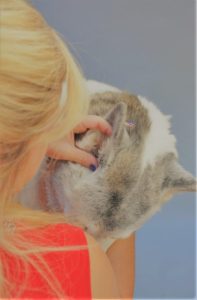
Begin at the head, removing dirt and waxy debris from ears with a soft cloth moistened with either a species specific solution or room temperature chamomile or green tea (hold the milk and sugar) – which calms inflammation and has anti-bacterial and anti-fungal properties. Of course store-bought cleaners can be used, but alcohol can be drying to the ear canal and can sting if your pet has scratched himself with his nails. Redness, a foul odor or what looks like coffee grounds? Get to the vet, as these could be signs of a yeast or fungal infection or the presence of ear mites, and require treatment.
If eyes tear excessively, have a thick discharge or if the pet is rubbing them, clean with purified water, flushing from the outer corner (upper lid gently held) so that fluid and debris run towards the snout. If that doesn’t alleviate discomfort, take your dog on-leash or kitty wrapped securely in a towel, safely into the sunlight. “A corneal lesion can cause severe squinting,” explains Martin Small, DVM. “Keep your pet in a dark room until you can get him to the vet. Darkness will lessen pain as the eye dilates.”
If it is more of a cosmetic issue, and you are battling tear and saliva stains, here is the product for you: https://pawtree.com/thepetsafetycrusader/products/2240
Also observe your dog or cat’s eyes for differences in pupil size (dark round centers on dogs/ellipses on cats). If one is larger (anisocoric), your pet needs prompt medical attention. Nervous system abnormalities, as well as infection, inflammation, cancer or trauma can be the cause. Barbara Davis of Tucson, Arizona, discovered her 3-year old Rottweiler’s pupils were unequally dilated and rushed him to the vet. The dog had ingested poisonous seed pods but Davis’ quick attention saved the day.
Continuing your examination, feel the muzzle. Tenderness to the touch or an unusual discharge from the nostrils should be examined by your vet.
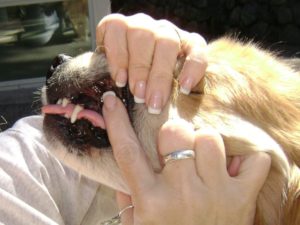
Check your furry friend’s mouth next, carefully! Gums should be a healthy pink (except for those cats with black gums and Chows or Black Labs) with no odor coming from the mouth. An unpleasant scent could indicate gum disease, tooth decay or gastrointestinal problems. Sweetness or an acetone-like scent could signal diabetes, but only your veterinarian knows for sure! Pay attention to hydration by feeling for moistness in the gums. Sloppy wet is good! Dry or sticky means you should encourage drinking or give water with an eyedropper or syringe. Adding a small bit of tuna juice might encourage your feline friend to drink up. If pet is lethargic, skin at nape of neck sticks together when gently pinched and/or eyes are sunken…high tail it to veterinary care! Every system of the body needs water.
What about the teeth? Most 2-3 year old pets that don’t brush regularly have peridontal disease. Try these veterinarian created treats to help freshen breath and loosen tartar.
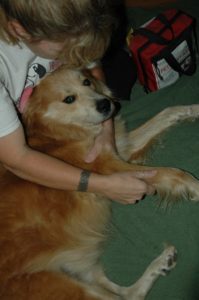
Think of the Rest as a Doggie or Kitty Massage
The rest of your head-to-tail exam is like a gentle massage, looking and feeling for things that don’t belong on your cat or dog — bumps, tenderness, wounds, parasites, burrs and foxtails — and that may have found their way onto or into a furry coat. When you reach the chest, you should be able to feel, the ribs (you may see a hint of rib on super lean breeds like Greyhounds, Whippets, or Rhodesian Ridgebacks). Breathing should be steady, 20-40 breaths per minute or a little slower, 10-30 bpm for older dogs and large breeds.
Inspect paws and legs, making sure pads are not cracked and nails are trimmed. Gently move at a speed that is comfortable for your pet, and only when you are in a good frame of mind yourself. Together you can enjoy this bonding experience and wellness check.
Kate Ahrens of Grand County, Colorado, was giving her dog, Bubba, a head-to-tail exam when the little guy screamed as she stretched his thigh, something she normally did without issue. After a trip to her ER vet, Bubba was diagnosed with a ruptured disc. “My veterinarian said that if I hadn’t discovered his pain, it could have been several more days before he exhibited signs delaying the help he needed,” says Ahrens.
Using your fingertips, stroke your dog or cat’s abdomen, checking for hard spots and tenderness. Look at mammary glands, genitals and “under the tail” — all should be clean with no colored discharge. If animal is older or arthritic and can’t perform his own hygiene, clean with a warm wet cloth
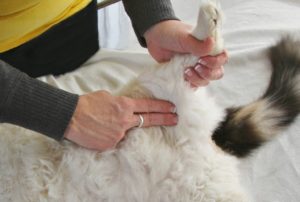
Keep records on all your pets noting their basic vitals. A GRRReat place to store that info is in your PET FIRST AID & CPR QUICK REFERENCE. Pulse is best palpated by feeling the Femoral Artery inside the thigh. Medium to large dogs should have a pulse of 60-90 while small dogs range between 90-160 and cats as high as 200 beats per minute.
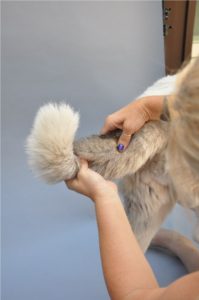
Long or short, fluffy or hairless, your pet’s tail too should be examined for lumps and sore spots, remembering that the base of the tail often harbors parasites. Quick Tip: If you don’t notice fleas but find dirt, clean your flea comb onto a damp paper towel. If the towel turns pink, that’s dried blood from the pet, so fleas are present.
Throughout your assessment, notice your pet’s skin and coat for dryness or excess shedding. The right brush can feel like a massage, stimulating oil glands as you stroke. Should you notice anything not quite right, contact your veterinarian.
The Tail End
Conclude your head-to-tail check-up with a game of ball, belly rubs or a healthy treat, and take note of habits as well: How often must water bowl be refilled or litter box cleaned? Does pet lean to one side as he walks or sits, moan or labor getting up or down? Anything unusual, could be a sign that your pet is suffering in silence.
Know the shortest route to your Animal Emergency Hospital, and regularly…get down on all fours to keep dangers out of paws and claws reach. It’s always a smart idea to stay prepared to handle what life throws your way by keeping your pet first aid kit up-to-date and refreshing pet first aid skills frequently.
For 20 years Denise Fleck’s Sunny-dog Ink motto has been “Helping people to help their pets,” and she has…personally having taught more than 30,000 pet lovers animal life-saving skills and millions more on “The Doctors,” CNN, “Kirstie Alley’s Big Life,” Animal Planet and other TV shows. Denise is a frequent conference speaker, developed a line of pet first aid kits, written a dozen books and now offers classes online. Learn more at www.PetSafetyCrusader.com


